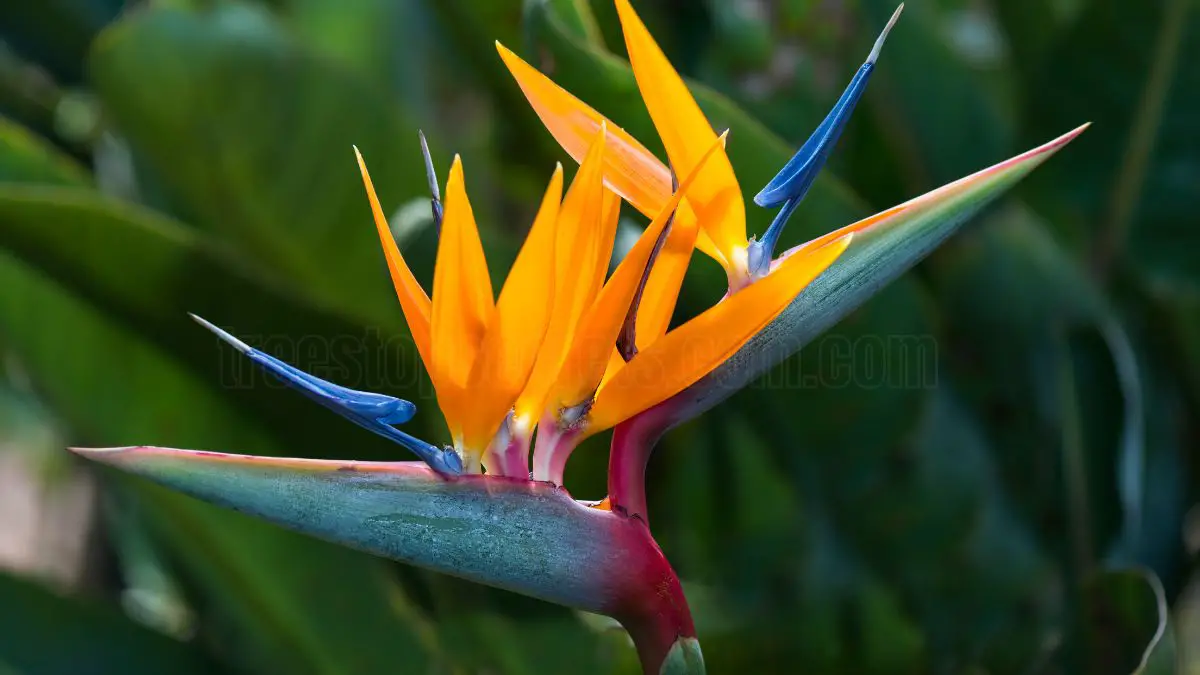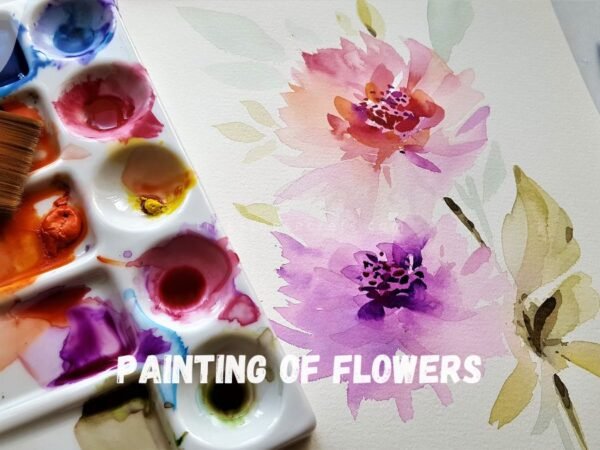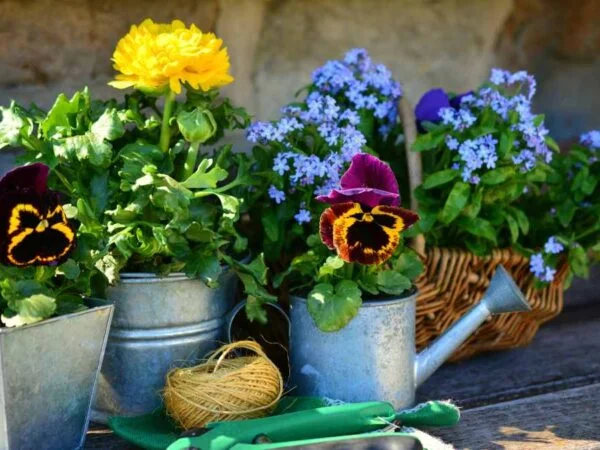Bird of paradise indoor care, or the growing experience and plant care they need indoors to succeed and grow beautifully. Native to tropical regions, these plants do best in bright, indirect light and warm temperatures in the range of 65°F to 70°F.
Don’t overwater your houseplants. Water regularly, allowing the soil to dry slightly between waterings, but do not let the plant dry out completely. Overwatering can lead to root rot.
Feed regularly with a balanced, water-soluble fertilizer during the growing season to encourage healthy foliage and colorful flowers.
Repotting every 2-3 years will not only replenish the soil but give him room to keep growing. By getting to know these essential care needs, you’ll be able to bask in the stunning splendor of bird of paradise inside your home.
Key Takeaways
- The Bird of Paradise flourishes in warm, brilliant environments as vibrant as its indigenous South African home. Make sure it receives lots of bright sunlight, and if possible, keep it by a south-facing window.
- Keep indoor temperatures between 65-80°F and humidity levels high to avoid scorching leaves. If you live in an extremely dry atmosphere, think about using a humidifier or a pebble tray to add moisture.
- Watering your Bird of Paradise Ideally, you want to water your plant when the top half of the soil is dry. Be sure to provide adequate drainage to avoid root rot! Throw away any remaining water in the saucer.
- To encourage strong growth, plant in a well-draining potting mix and fertilize every month during the growing season. Do not fertilize in winter while the plant is dormant.
- Dead or damaged leaves should be regularly pruned to open up space for new growth to emerge and to keep the plant looking tidy. Removing dead leaves avoids overcrowding and encourages bushier growth.
- Keep an eye out for developing yellow leaves and pest indications. Fix these problems as soon as possible to ensure your plants remain happy. Consistent, careful observation of your plant will help you catch issues before they become big problems later on.
Understanding the Bird of Paradise Plant
The stunning Bird of Paradise plant, scientifically called Strelitzia Nicolai, is a tropical evergreen that brings a tropical flair to any indoor space. This vibrant foliage thrives in warm climates and can adapt well to its environment, making it an ideal choice for gardeners looking to grow paradise plants indoors with appropriate care.
What Is a Bird of Paradise Plant?
As a member of the unique Strelitziaceae family, the Bird of Paradise is more commonly known as the “crane flower.” Its big, wide, flat leaves grow upward so proudly and tall—it’s not unusual for their leaves to reach a meter (three feet) high indoors!
The plant’s strikingly exotic appearance, combined with the fact that it’s not too terribly demanding to care for, has only endeared it to the masses further.
Symbolism and Meaning of the Bird of Paradise
Joy, freedom, paradise. This plant is a symbol of happiness and paradise. In fact, its rich colors and unusual form practically scream beauty and exoticism.
This quality lends itself well to its popularity in floral arrangements and gifts celebrating happiness and momentous occasions.
Flowering Characteristics of the Bird of Paradise
The exotic flowers, which can look like a bird in flight, usually feature fiery orange and deep blue colors. The leaves are still stunning; however, indoor conditions are unlikely to encourage them to bloom.
If you want this tropical plant to flower, it needs lots of sun and warmth, both of which can be hard to reproduce indoors.
Familiarity with these basic characteristics can do wonders to increase your growth game. Your plant will be happiest growing in bright, indirect light and 65-80°F temperatures.
Consistent watering is key, allowing the top 2-3 inches of soil to dry out between waterings.
Optimal Indoor Conditions for Growth
For your Bird of Paradise to thrive indoors, providing conditions similar to its native environment is key. Like any tropical plant, it wants to grow in the best possible light conditions—adequate sunlight, temperature, humidity, and soil quality. Consistently monitoring these factors helps ensure your plants not only thrive but showcase their vibrant foliage in all its rich, colorful glory.
1. Light Requirements: Natural vs. Artificial
The Bird of Paradise thrives in direct sunlight or bright indirect light. The best lighting is achieved by placing the plant close to east- or west-facing windows. If your plants don’t have enough natural light, you can opt to supplement with grow lights.
Not enough light will result in leggy growth and no blossoming, so never allow your plant to be in low light for extended time.
2. Ideal Temperature and Humidity Levels
Ideally, this plant prefers temperatures between 65-80°F (16-27°C). Though able to withstand temperatures below freezing as low as 24°F (-4°C), prolonged exposure to cold will harm the plant.
Proper humidity levels are just as important for plant health. To keep humidity high and avoid the dreaded crispy leaf tip, invest in a humidifier or a pebble tray.
3. Watering Guidelines to Prevent Root Issues
Water the Bird of Paradise only when about half the soil is dry. Water thoroughly until it drains out the bottom, but make sure to pour out excess water so roots don’t sit in it and rot.
During the winter, the plant needs less water, since it goes into a resting period.
4. Best Soil Mix and Fertilization Practices
Using a mixture of high-quality, well-draining potting mix will provide moisture retention without over-saturation. To encourage healthy growth, fertilize once a month with a general-purpose fertilizer during the growing season.
During winter, avoid fertilization to avoid nutrient accumulation.
Caring for Your Indoor Bird of Paradise
Proper care for your indoor Bird of Paradise, a stunning plant that adds tropical flair, will take some time and effort on your part, but the vibrant foliage will be worth it.
1. Pruning Techniques for Healthy Growth
Routine pruning is important for promoting fresh growth and maintaining appearance. Remove any dead or damaged foliage to encourage healthy growth.
Trimming back lanky, leggy growth encourages a fuller, denser plant and reduces the risk of strangling other stems in tight quarters. Always prune with clean, sharp tools to reduce stress and injury on your plant.
2. Propagation Methods for Expanding Your Collection
You can propagate a bird of paradise by dividing the plant or planting seeds. In general, choose the healthiest parent plants to ensure the greatest success.
When you do divide, make sure that each section has a healthy shoot or two and a strong root system. Whether propagated from seeds or cuttings, newly introduced plants will need to be monitored closely with consistent sunlight and moisture.
3. Placement Tips for Maximizing Space and Light
Keep your Bird of Paradise in proximity to windows with plenty of direct light to encourage development. Frequent rotation of the plant will mean all sides get a chance to grow evenly, avoiding the plant from looking lopsided.
Plant stands or multi-tiered shelves allow you to maximize vertical space, while creating an interesting display that catches the eye.
Other care requirements other than watering are ensuring they’re not sitting in soggy soil which causes their leaves to droop. Every 18-28 months, repotting will keep it a little pot-bound, which is just fine, with spring a good time to tackle that chore.
Weekly fertilization during the active growing season creates ideal conditions for vigorous growth.
Troubleshooting Common Problems
Early detection and intervention are key to keeping your Bird of Paradise healthy. Regular observation of your paradise plants allows you to spot signs of stress or pest infestations before they escalate, ensuring your stunning plant remains vibrant and thriving.
1. Identifying Yellow Leaves and Their Causes
Whether it is due to overwatering, underwatering, or a nitrogen deficiency, yellowing leaves are never a good sign. To fix this, you’ll need to check the soil moisture. If it’s too wet, scale back your watering.
If it’s too dry, water more. Check for signs of infestations or diseases that may be causing the leaves to yellow. A little detective work can help you identify bigger issues that require urgent action.
2. Pest Management Strategies for Indoor Plants
Spider mites and aphids are two common pests that can infest the Bird of Paradise. To treat these infestations, reach for neem oil or insecticidal soap, two powerful but gentle treatments.
Maintaining a clean area around your plant is important, too. Consistent litter and fallen leaf removal can greatly reduce the chances of creating a pest problem.
3. Recognizing Signs of Stress or Nutrient Deficiency
Symptoms like drooping leaves, browning leaf margins, and stunted growth are all obvious signs of stress. Consider environmental factors as well, from exposure to direct sunlight to over- or underwatering, and low humidity levels.
Adjusting care practices accordingly, such as repositioning the plant for optimal light or modifying your watering schedule, can alleviate stress and restore health.
Creating a Tropical Microclimate Indoors
Creating a microclimate that recreates the Bird of Paradise’s natural habitat is key to caring for it indoors. As paradise plants, they thrive in warm, humid environments, and ensuring adequate sunlight will promote healthy, vibrant foliage and stunning blooms.
1. Adjusting Environmental Factors for Thriving Plants
Consistently measuring temperature and humidity levels is key. Try to maintain a temperature range of 65°F to 70°F and a humidity range of 60-70%.
Be sure to adjust their placement according to the change in seasons and the natural sunlight that accompanies them. For instance, bring plants closer to windows in the winter and offer protection from direct sun during the hottest days of the year.
Invest in tools such as hygrometers and thermometers to help measure and monitor conditions over time. This is key to maintaining an environment where your plants will thrive.
2. Utilizing Humidifiers and Grow Lights Effectively
Choosing the best humidifier for your space can be a game changer. An ultrasonic humidifier is a good bet. It releases a cool, visible mist that raises humidity levels without saturating the air.
Grow lights can help provide light in the fall and winter when days are shorter. Keeping the grow lights at least 12-18 inches above the plant and ensuring they are exposed to the lights for at least 12-14 hours a day will optimize growth.
Monitor and adjust the duration as needed according to how the plant responds to help achieve the best results.
Conclusion
With dedication and attention to detail, providing bird of paradise indoor care can be a fun challenge. Ensure it receives plenty of bright light, warmth, and humidity to allow your bird of paradise to flourish. A good schedule of regular watering and feeding will help the plant thrive and stay beautiful. Keep an eye out for signs of trouble such as pest invasions or browning of the leaves, and treat them promptly so your plant can thrive. Making your indoor environment as tropical as possible not only helps your plant thrive, but it brings a vibrant tropical aura to your living space.
Have fun getting to know your new plant companion. Show your bird of paradise the love and care it deserves. Soon enough, it’ll bloom into a magnificent statement maker in your house! Take the plunge and watch your indoor garden thrive.
Frequently Asked Questions
What is a Bird of Paradise plant?
What is a Bird of Paradise plant? These stunning plants, with their vibrant foliage resembling a bird in flight, enhance the mystique of any indoor space. With adequate sunlight and proper care, they can thrive indoors, reaching up to 10 feet tall.
How much light does a Bird of Paradise need indoors?
This stunning plant thrives best when it can soak up bright, indirect sunlight. For optimal growth and flowering, place it in a sunny spot near a south or west-facing window to ensure adequate light exposure.
How often should I water my indoor Bird of Paradise?
Water your indoor Bird of Paradise once the top inch of soil is dry, which may occur every 1-2 weeks depending on the humidity and indoor temperatures of your home.
What type of soil is best for Bird of Paradise?
Plant in a loose, well-draining potting mix high in organic content, ideal for paradise plants. This blend, designed for tropical plants, creates ample space for air circulation around the roots.
How can I encourage my Bird of Paradise to bloom?
To encourage flowering, ensure your plant receives abundant light.
Humidity & FertilizingMaintain high humidity and fertilize every 4-6 weeks during the growing season with a balanced fertilizer.
What should I do if my Bird of Paradise has yellow leaves?
Yellow leaves on your paradise plants could indicate overwatering or poor drainage. It's essential to monitor the soil moisture levels and ensure the pot has adequate drainage holes to prevent root rot.
Can I keep my Bird of Paradise outside in Los Angeles?
Yes! Can I keep my Bird of Paradise outside in Los Angeles? So long as you provide it with ample sunlight and shield it from high winds, it should thrive beautifully.
Image Source: Paid image from CANVA




